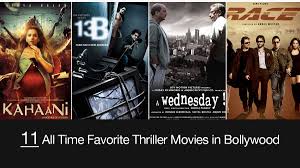Indian cinema has gone through a lot of phases in respective decades. One of the most interesting and versatile forms of storytelling was that of the thriller genre. An agglomerate of genres, from the conventional whodunit to the avant-garde psychological thriller, Indian thrillers have established a personality of their own, incorporating bred-in-the-bone cultural peculiarities with universal cinematic sensibilities. This article explores the journey of the thriller in Indian cinema, tracing significant films, landmark moments, and the appeal of the genre among audiences.
Discover the evolution of the thriller genre in Indian cinema, from classic crime mysteries to contemporary psychological thrillers. A journey through India’s most gripping films and trends.
Thrillers have always been special in Indian cinema Pairing suspense, intrigue and adrenaline for audiences. Growing and adapting to changing and progressing narratives across society, technology, and audiences, the genre has evolved to deliver chilling events and keep viewers guessing ahead of any content. But did Indian thrillers have an origin? When was this genre born, and what were the key developments that have shaped what we know today? Let’s unravel the journey.
Early Days: The Birth of Suspense in Indian Cinema
Setting the Stage: Pre-Independence Era
The seeds of thrillers in Indian cinema were sown during the pre-independence era, when silent films began experimenting with mystery and suspense. Early films like Jamai Babu (1931) showcased rudimentary elements of suspense within a narrative framework dominated by drama and romance.
However, it was the post-independence era that marked the true advent of the thriller genre. Directors began exploring darker and more complex themes, influenced by Western noir films and literary classics. Films like Mahal (1949), directed by Kamal Amrohi, introduced audiences to gothic suspense, with its haunting storyline and mesmerizing performances.
The Golden Era: 1950s to 1970s
Crime Thrillers and Noir Influences
The 1950s to 1970s were a transformative period for Indian thrillers. With the advent of sound and advancements in filmmaking, directors began experimenting with crime thrillers. Guru Dutt’s Baazi (1951) and Raj Khosla’s CID (1956) were pioneers in this space, blending suspense with music and romance to appeal to a wider audience.
Rise of Suspense Queens
This era also saw actresses like Vyjayanthimala and Sadhana becoming icons of the genre. Films like Woh Kaun Thi? (1964) and Mera Saaya (1966) introduced the concept of psychological suspense, where characters’ motives and identities were shrouded in mystery.
The Experimental Phase: 1980s to 1990s
Thrillers in the Masala Era
The 1980s brought a mix of experimentation and commercialism. Directors like Mani Ratnam redefined the genre with films like Roja (1992), which combined political intrigue with personal drama. Meanwhile, action thrillers like Tezaab (1988) and Baazigar (1993) blurred the lines between traditional thrillers and action-packed masala films.
Parallel Cinema and Realistic Thrills
Parallel cinema also played a crucial role during this period, with filmmakers like Govind Nihalani crafting intense and realistic thrillers such as Ardh Satya (1983). These films, rooted in societal issues, brought a new dimension to the genre, focusing on the psychological depth of characters.
The New Millennium: A Modern Take on Thrillers
Rise of Psychological and Neo-Noir Thrillers
The 2000s witnessed a significant shift, with filmmakers adopting global storytelling techniques. Films like Kahaani (2012) and Andhadhun (2018) showcased complex narratives, unreliable narrators, and unconventional endings. The success of these films highlighted the growing appetite for intellectually stimulating content.
Influence of Regional Cinema
Regional cinema, particularly from South India, also contributed to the thriller genre’s evolution. Tamil films like Ratsasan (2018) and Telugu hits like Evaru (2019) introduced innovative storylines, focusing on psychological depth and taut screenplays.
Technological Advancements and OTT Revolution
Thrillers in the Digital Age
The rise of streaming platforms has revolutionized Indian cinema, giving filmmakers more creative freedom. OTT platforms like Netflix and Amazon Prime Video have become hubs for experimental thrillers, allowing creators to push boundaries without the constraints of traditional box-office demands.
Notable OTT Thrillers
Series like Sacred Games and Paatal Lok have brought global recognition to Indian thrillers, showcasing intricate plots and well-developed characters. These digital platforms have also made it easier for regional thrillers to reach a wider audience.
Key Themes and Trends in Indian Thrillers
Emerging Themes
- Women-Centric Narratives: Films like Kahaani and Pink place strong female protagonists at the center of suspenseful storylines.
- Societal Issues: Thrillers such as Article 15 address pressing social concerns while maintaining an engaging narrative.
- Experimental Storytelling: Non-linear plots and ambiguous endings have become hallmarks of modern Indian thrillers.
Global Influence
Indian thrillers now draw inspiration from global cinema, incorporating elements of Korean, Scandinavian, and Hollywood thrillers to craft unique stories with universal appeal.
Indian cinema’s evolution of the thriller genre reflects the flexibility and inventiveness applied by the industry. From old diamantine to modern psychological dramas, Indian thrillers have intrigued the audiences with their innovativeness and depth. With constantly maturing technology and storytelling, the future of this genre will bring us even more compelling and diverse narratives.
FAQ: Frequently Asked Questions
Q1: What are some iconic Indian thriller movies?
Some iconic Indian thrillers include Mahal (1949), Kahaani (2012), Andhadhun (2018), and Ratsasan (2018).
Q2: How has technology impacted Indian thrillers?
Technology has enabled better special effects, improved cinematography, and the rise of OTT platforms, which allow for more experimental and niche storytelling.
Q3: Which regional cinema contributes the most to thrillers?
Tamil and Telugu cinemas are particularly notable for their contribution, with films like Ratsasan and Evaru gaining nationwide acclaim.
Q4: Are Indian thrillers popular internationally?
Yes, Indian thrillers are gaining international recognition, especially through OTT platforms that make them accessible to a global audience.
Q5: What is the future of thrillers in Indian cinema?
The future looks promising with the incorporation of advanced technology, diverse themes, and global influences, ensuring fresh and innovative storytelling.
